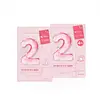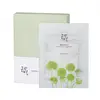What's inside
What's inside
 Key Ingredients
Key Ingredients

 Benefits
Benefits

 Concerns
Concerns

 Ingredients Side-by-side
Ingredients Side-by-side

Collagen Extract 65%
Skin ConditioningWater
Skin ConditioningGlycerin
HumectantDipropylene Glycol
Humectant1,2-Hexanediol
Skin ConditioningButylene Glycol
HumectantNiacinamide
SmoothingDimethicone
EmollientPEG-240/Hdi Copolymer Bis-Decyltetradeceth-20 Ether
StabilisingAmmonium Acryloyldimethyltaurate/Vp Copolymer
Hydroxyethylcellulose
Emulsion StabilisingCetearyl Olivate
Sorbitan Olivate
EmulsifyingEthylhexylglycerin
Skin ConditioningAdenosine
Skin ConditioningCollagen
MoisturisingMelia Azadirachta Flower Extract
Skin ConditioningCoccinia Indica Fruit Extract
Skin ConditioningMelia Azadirachta Leaf Extract
Skin ConditioningSolanum Melongena Fruit Extract
Skin ConditioningPropanediol
SolventAloe Barbadensis Flower Extract
EmollientCurcuma Longa Root Extract
MaskingCorallina Officinalis Extract
Skin ConditioningOcimum Sanctum Leaf Extract
Skin ConditioningPearl Powder
Hydrolyzed Elastin
EmollientHydrogenated Polyisobutene
EmollientBenzyl Glycol
SolventHydrolyzed Glycosaminoglycans
HumectantSodium Hyaluronate
HumectantHibiscus Sabdariffa Flower Extract
Skin ConditioningPearl Extract
AntioxidantRosa Canina Fruit Extract
AstringentHydrolyzed Conchiolin Protein
Skin ConditioningSodium Hyaluronate Crosspolymer
HumectantHydrolyzed Hyaluronic Acid
HumectantHydroxypropyltrimonium Hyaluronate
Glutathione
Hyaluronic Acid
HumectantCopper Tripeptide-1
Skin ConditioningAnemarrhena Asphodeloides Root Extract
Skin ConditioningSodium Acetylated Hyaluronate
HumectantTocopherol
AntioxidantDisodium EDTA
Parfum
MaskingCollagen Extract 65%, Water, Glycerin, Dipropylene Glycol, 1,2-Hexanediol, Butylene Glycol, Niacinamide, Dimethicone, PEG-240/Hdi Copolymer Bis-Decyltetradeceth-20 Ether, Ammonium Acryloyldimethyltaurate/Vp Copolymer, Hydroxyethylcellulose, Cetearyl Olivate, Sorbitan Olivate, Ethylhexylglycerin, Adenosine, Collagen, Melia Azadirachta Flower Extract, Coccinia Indica Fruit Extract, Melia Azadirachta Leaf Extract, Solanum Melongena Fruit Extract, Propanediol, Aloe Barbadensis Flower Extract, Curcuma Longa Root Extract, Corallina Officinalis Extract, Ocimum Sanctum Leaf Extract, Pearl Powder, Hydrolyzed Elastin, Hydrogenated Polyisobutene, Benzyl Glycol, Hydrolyzed Glycosaminoglycans, Sodium Hyaluronate, Hibiscus Sabdariffa Flower Extract, Pearl Extract, Rosa Canina Fruit Extract, Hydrolyzed Conchiolin Protein, Sodium Hyaluronate Crosspolymer, Hydrolyzed Hyaluronic Acid, Hydroxypropyltrimonium Hyaluronate, Glutathione, Hyaluronic Acid, Copper Tripeptide-1, Anemarrhena Asphodeloides Root Extract, Sodium Acetylated Hyaluronate, Tocopherol, Disodium EDTA, Parfum
Water
Skin ConditioningCentella Asiatica Extract
CleansingGlycereth-26
HumectantButylene Glycol
HumectantNiacinamide
Smoothing1,2-Hexanediol
Skin ConditioningHydroxyacetophenone
AntioxidantArginine
MaskingAcrylates/C10-30 Alkyl Acrylate Crosspolymer
Emulsion StabilisingHydroxyethylcellulose
Emulsion StabilisingCarrageenan
Polyglyceryl-4 Caprate
EmulsifyingPolyglyceryl-6 Caprylate
EmulsifyingAdenosine
Skin ConditioningEthylhexylglycerin
Skin ConditioningDisodium EDTA
Helianthus Annuus Seed Oil
EmollientPanthenol
Skin ConditioningArtemisia Princeps Leaf Extract
Skin ConditioningLycium Chinense Fruit Extract
AntioxidantPropanediol
SolventPortulaca Oleracea Extract
Skin ConditioningPanax Ginseng Root Extract
EmollientCamellia Sinensis Leaf Extract
AntimicrobialAnthemis Nobilis Flower Oil
MaskingSodium Hyaluronate
HumectantHydrolyzed Hyaluronic Acid
HumectantHyaluronic Acid
HumectantWater, Centella Asiatica Extract, Glycereth-26, Butylene Glycol, Niacinamide, 1,2-Hexanediol, Hydroxyacetophenone, Arginine, Acrylates/C10-30 Alkyl Acrylate Crosspolymer, Hydroxyethylcellulose, Carrageenan, Polyglyceryl-4 Caprate, Polyglyceryl-6 Caprylate, Adenosine, Ethylhexylglycerin, Disodium EDTA, Helianthus Annuus Seed Oil, Panthenol, Artemisia Princeps Leaf Extract, Lycium Chinense Fruit Extract, Propanediol, Portulaca Oleracea Extract, Panax Ginseng Root Extract, Camellia Sinensis Leaf Extract, Anthemis Nobilis Flower Oil, Sodium Hyaluronate, Hydrolyzed Hyaluronic Acid, Hyaluronic Acid
 Reviews
Reviews

Ingredients Explained
These ingredients are found in both products.
Ingredients higher up in an ingredient list are typically present in a larger amount.
1,2-Hexanediol is a synthetic liquid and another multi-functional powerhouse.
It is a:
- Humectant, drawing moisture into the skin
- Emollient, helping to soften skin
- Solvent, dispersing and stabilizing formulas
- Preservative booster, enhancing the antimicrobial activity of other preservatives
Adenosine is in every living organism. It is one of four components in nucleic acids that helps store our DNA.
Adenosine has many benefits when used. These benefits include hydrating the skin, smoothing skin, and reducing wrinkles. Once applied, adenosine increases collagen production. It also helps with improving firmness and tissue repair.
Studies have found adenosine may also help with wound healing.
In skincare products, Adenosine is usually derived from yeast.
Learn more about AdenosineButylene Glycol (or BG) is used within cosmetic products for a few different reasons:
Overall, Butylene Glycol is a safe and well-rounded ingredient that works well with other ingredients.
Though this ingredient works well with most skin types, some people with sensitive skin may experience a reaction such as allergic rashes, closed comedones, or itchiness.
Learn more about Butylene GlycolDisodium EDTA plays a role in making products more stable by aiding other preservatives.
It is a chelating agent, meaning it neutralizes metal ions that may be found in a product.
Disodium EDTA is a salt of edetic acid and is found to be safe in cosmetic ingredients.
Learn more about Disodium EDTAEthylhexylglycerin (we can't pronounce this either) is commonly used as a preservative and skin softener. It is derived from glyceryl.
You might see Ethylhexylglycerin often paired with other preservatives such as phenoxyethanol. Ethylhexylglycerin has been found to increase the effectiveness of these other preservatives.
Hyaluronic acid is naturally found in healthy skin. It is a humectant, meaning it draws moisture to your skin.
This ingredient helps hydrate, soothe, and protect the skin.
What makes hyaluronic acid so hydrating? It has the capacity to bind or hold large amounts of water.
Fun fact: It is already naturally found in our bodies, such as the fluids of our eyes and our joints.
Studies find this ingredient to have anti-inflammatory and anti-microbial properties. This can help speed up wound-healing.
Hyaluronic acid can be irritating if the molecule has a low-molecular weight, or if the molecules are small.
One study found low-molecular weight hyaluronic acid to be pro-inflammatory, meaning some people may experience irritation. This is because our bodies use hyaluronic acid in the wound-healing process to signal to our bodies, via irritation, that something needs healing.
The same study found high-molecular weight hyaluronic acid to be anti-inflammatory.
These are some other common types of Hyaluronic Acid:
Learn more about Hyaluronic AcidHydrolyzed Hyaluronic Acid is a form of hyaluronic acid. It is created by the hydrolysis of hyaluronic acid with a high molecular weight. Once created, Hydrolyzed Hyaluronic Acid has a low molecular weight.
Low molecular weight HA has been shown to hydrate and increase elasticity of the skin. Increasing elasticity is also associated with reduction of wrinkle depth.
One study found topical low molecular weight hyaluronic acid may be considered for the treatment of rosacea in the adult population. However, we always recommend speaking with a professional about your skin concerns.
Hyaluronic acids are a humectant. This means they draw moisture from the air. Hyaluronic acids help moisturize, soothe, and protect the skin.
Read more about other common forms of hyaluronic acid:
Learn more about Hydrolyzed Hyaluronic AcidHydroxyethylcellulose is used to improve the texture of products. It is created from a chemical reaction involving ethylene oxide and alkali-cellulose. Cellulose is a sugar found in plant cell walls and help give plants structure.
This ingredient helps stabilize products by preventing ingredients from separating. It can also help thicken the texture of a product.
This ingredient can also be found in pill medicines to help our bodies digest other ingredients.
Learn more about HydroxyethylcelluloseNiacinamide is a multitasking form of vitamin B3 that strengthens the skin barrier, reduces pores and dark spots, regulates oil, and improves signs of aging.
And the best part? It's gentle and well-tolerated by most skin types, including sensitive and reactive skin.
You might have heard of "niacin flush", or the reddening of skin that causes itchiness. Niacinamide has not been found to cause this.
In very rare cases, some individuals may not be able to tolerate niacinamide at all or experience an allergic reaction to it.
If you are experiencing flaking, irritation, and dryness with this ingredient, be sure to double check all your products as this ingredient can be found in all categories of skincare.
When incorporating niacinamide into your routine, look out for concentration amounts. Typically, 5% niacinamide provides benefits such as fading dark spots. However, if you have sensitive skin, it is better to begin with a smaller concentration.
When you apply niacinamide to your skin, your body converts it into nicotinamide adenine dinucleotide (NAD). NAD is an essential coenzyme that is already found in your cells as "fuel" and powers countless biological processes.
In your skin, NAD helps repair cell damage, produce new healthy cells, support collagen production, strengthen the skin barrier, and fight environmental stressors (like UV and pollution).
Our natural NAD levels start to decline with age, leading to slower skin repair, visible aging, and a weaker skin barrier. By providing your skin niacinamide, you're recharging your skin's NAD levels. This leads to stronger, healthier, and younger looking skin.
Another name for vitamin B3 is nicotinamide. This vitamin is water-soluble and our bodies don't store it. We obtain Vitamin B3 from either food or skincare. Meat, fish, wheat, yeast, and leafy greens contain vitamin B3.
The type of niacinamide used in skincare is synthetically created.
Learn more about NiacinamidePropanediol is an all-star ingredient. It softens, hydrates, and smooths the skin.
It’s often used to:
Propanediol is not likely to cause sensitivity and considered safe to use. It is derived from corn or petroleum with a clear color and no scent.
Learn more about PropanediolSodium Hyaluronate is hyaluronic acid's salt form. It is commonly derived from the sodium salt of hyaluronic acid.
Like hyaluronic acid, it is great at holding water and acts as a humectant. This makes it a great skin hydrating ingredient.
Sodium Hyaluronate is naturally occurring in our bodies and is mostly found in eye fluid and joints.
These are some other common types of Hyaluronic Acid:
Learn more about Sodium HyaluronateWater. It's the most common cosmetic ingredient of all. You'll usually see it at the top of ingredient lists, meaning that it makes up the largest part of the product.
So why is it so popular? Water most often acts as a solvent - this means that it helps dissolve other ingredients into the formulation.
You'll also recognize water as that liquid we all need to stay alive. If you see this, drink a glass of water. Stay hydrated!
Learn more about Water